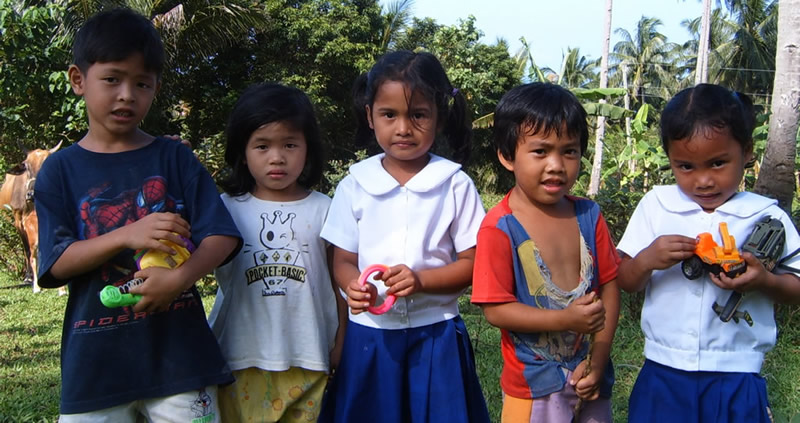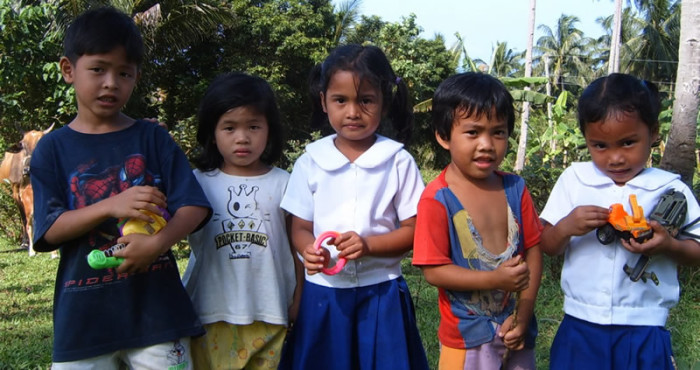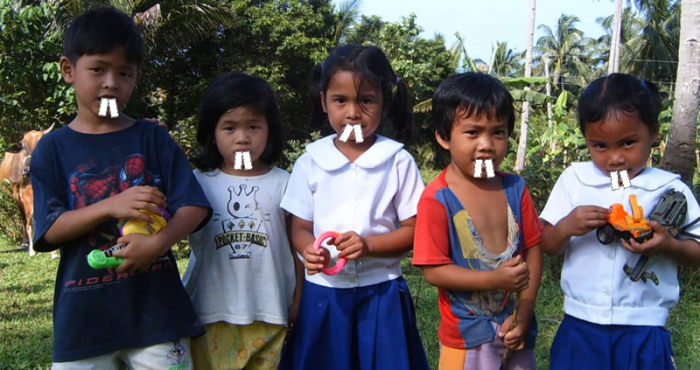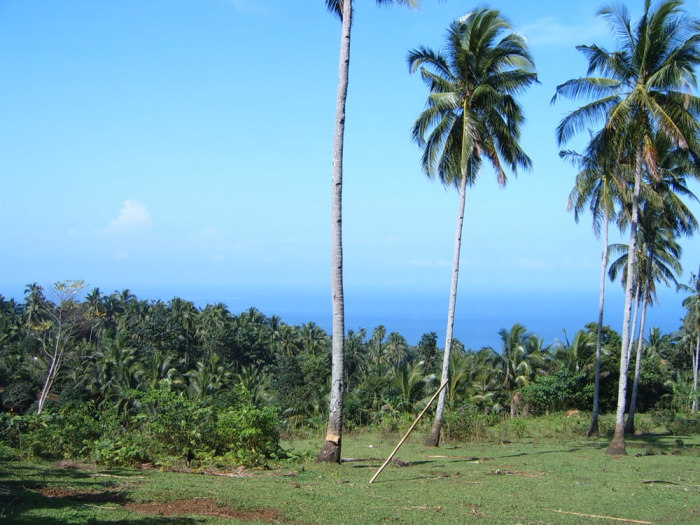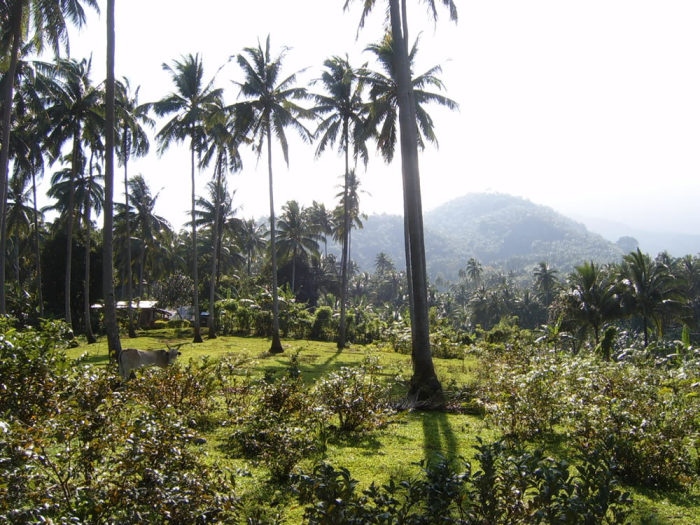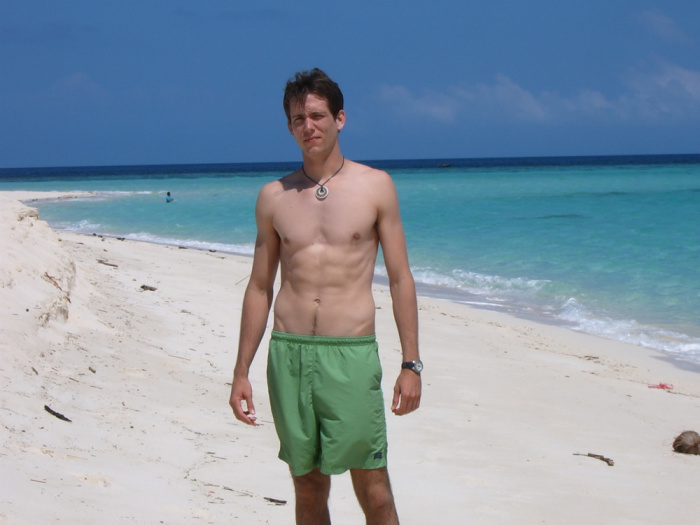My problem in relating my adventures these days is not deciding where to begin, but where to end…
Gee, what a clever little sentence that was!
Perhaps you noticed the new panoramic picture in the previous journal? the catchy island slogan? Don’t give me the credit, I couldn’t make up something that cheesy if my life depended on it. That’s the tourism bureau’s official catch-phrase for this silly rock. I took the pictures used to make the panorama from White Island, a small coral & sand key about a mile offshore from my sitio (village).
Camiguin is an oval shape of sorts and unfortunately for you I live on the north end, the skinny end. So the perspective of this picture keeps you from seeing all 7 volcanic peaks we have here. We’ve had a lovely string of sunny days this past week, but even so I’ve yet to see the top of the highest mountain on the island, Mt. Hibok-Hibok — that’s it dead center with clouds obscuring its upper reaches as usual. You can see three large white specks in the middle of the shoreline, that is Paras Beach Resort where you can stay and pay 900x the actual retail price for anything your heart desires. I currently live in YumBing, the sitio (village) directly behind it, perhaps 50m from the ocean.
I’m going to go ahead and warn you in advance that this is the last you’ll be hearing from me until… *checking my calendar* … … March 4th. I’ll get to why later on, but we’ve got a lot of ground to cover before the emotional goodbyes begin.
Cute kids, aren’t they? For just $2 a day YOU can make a difference in a child’s life! Ha! Just kidding! The reality is these lil’ bastards will happily steal the shirt off your back the moment you take your eyes off ’em! The one on the far left is actually 17 years old — everyone calls him “Babyface.” Look at the girl next to him, you know she’s just thinking “I’ll steal the tall sucker’s wallet the second he turns away” — you can see it in her eyes!
Ok ok, so that’s not exactly “the truth” either… The real story is that these five darling children, who were kind enough to let me play with their toy phone, pink ring, orange truck, and army helicopter, are residents of San Isidro — my study area. This past Wednesday Melvin and I made our introductory trip up to the barangay(~municipality) to introduce ourselves to the community organization leaders and formally state the objectives and requirements of my visit to Camiguin. Upon our initial arrival we were introduced to Jorge, the community organization’s(CO) acting president and I, with the aid of Melvin’s translations, briefly interviewed him about some preliminary questions and confusions I had over the Community-Based Forestry Management(CBFM) project. Once I was finished Melvin produced the Cebuano version of my survey. We had to pre-test it in the hopes of uncovering any confusing questions, redundancies, or questions that were just not possible for people to answer and would have to be removed or recomposed. As the survey was entirely in a language I don’t speak, my presence was no longer required so I snapped a quick picture of the proceedings and stepped outside.
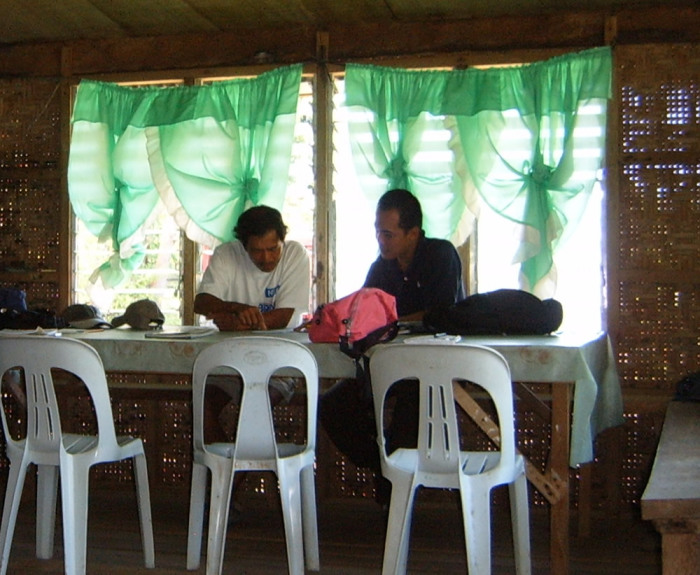
Finding myself with at least half and hour to kill – my survey being quite thorough – I wandered off down the foot trails deeper into the San Isidro barangay. To give you an idea of the location of this place: Camiguin has one road that rings the island, never wandering more than 200m from the shore. To get to San Isidro you must make a turn off this main road and head directly in towards the center of the island for 6km, only the first 4km of which are paved. Forgive my lack of maps, my electronic resources are *extremely* limited these days. But at this point the island itself is only 15km wide, so these people are way, way up on the sides of the volcanoes and have little to no interaction with the seaside communities. And those last 2 “unpaved” kilometers? They ain’t your nice country roads… More like they’re your “my head just put a crack in the window glass, I think I’ve involuntarily wet myself, and I’m pretty sure one of my retinas just detached” bumpy — yeah, they’re totally awesome! To put it another way, everyone walks(except us).
So off I wandered away from the CO building and out into the wilder bits of the barangay.
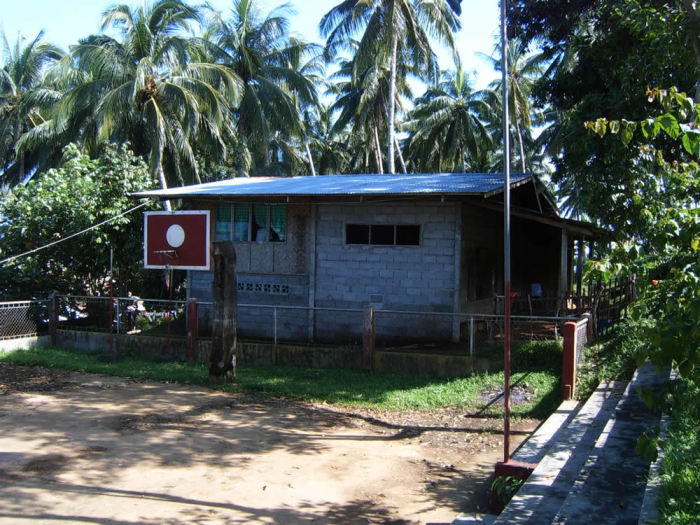
This was the point when I was beaten and robbed, err, I mean greeted and mobbed, by those five little angels – who never left my side for the next 30 minutes.
Seeing as how they have no substantial contact with any off-mountain communities, the San Isidro residents – composing ~80 households – are subsistence farmers of primarily coconut, banana, and a variety of smaller-scale crop plantings(rice, corn, potatoes, etc.) This is an actual coconut grove, and you can see the husks of the harvested coconuts are left scattered or in piles on the ground around the trees to decompose and return what little nutrients they have back into the soil.
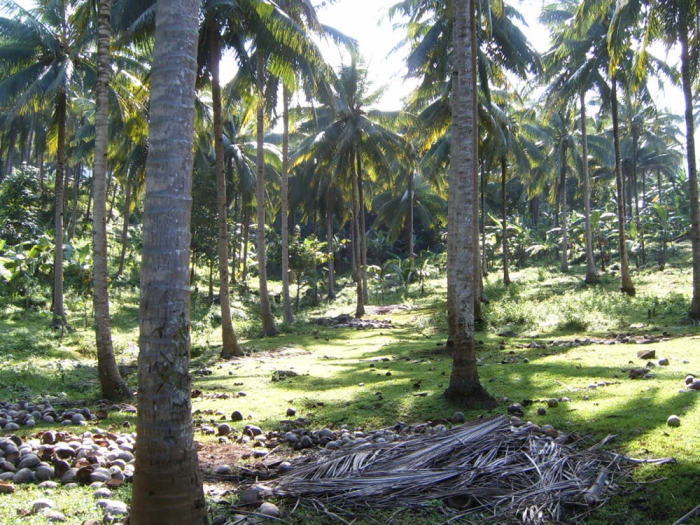
Were I not such a serious, coldhearted, and generally humorless person I might be inclined to dub the San Isidro residents “Squirrel People.” The correlation is easily divined when everywhere one looks there are neatly(or sometimes not so) stacked piles of shelled coconut remnants. An even sillier person would then expect all the residents to have ridiculously enlarged front teeth, but at that point you’d just be acting juvenile…
So eventually my friends and I reached a small cluster of houses, but not before first passing this denizen of the deep.
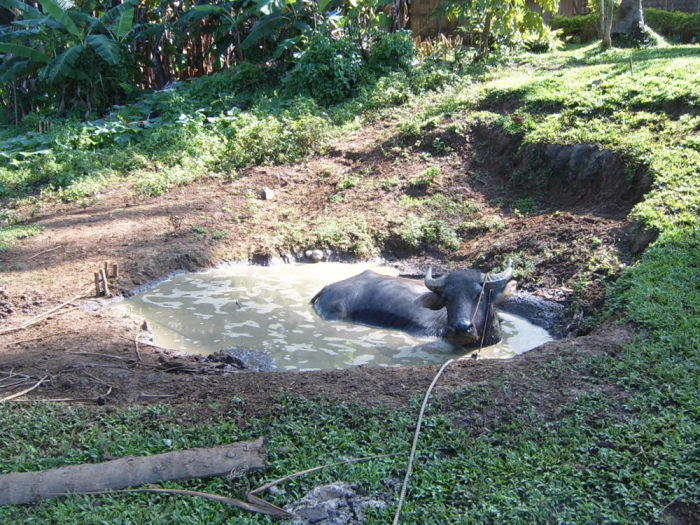
A sharp eye reveals the universally employed way of securing all large livestock on Camiguin – you punch a rope through the septum of the animal’s nose and then either tie a big knot or a hunk of wood onto the end thereby making it impossible for the animal to escape so long as it values its nostrils.
Here are two standard San Isidro households.
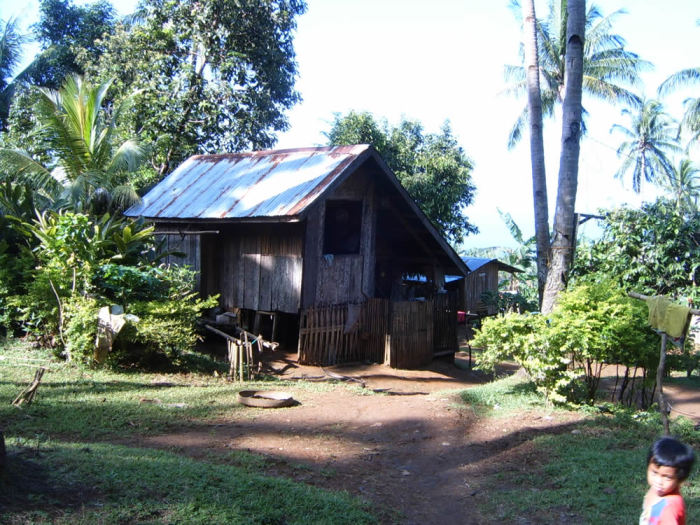
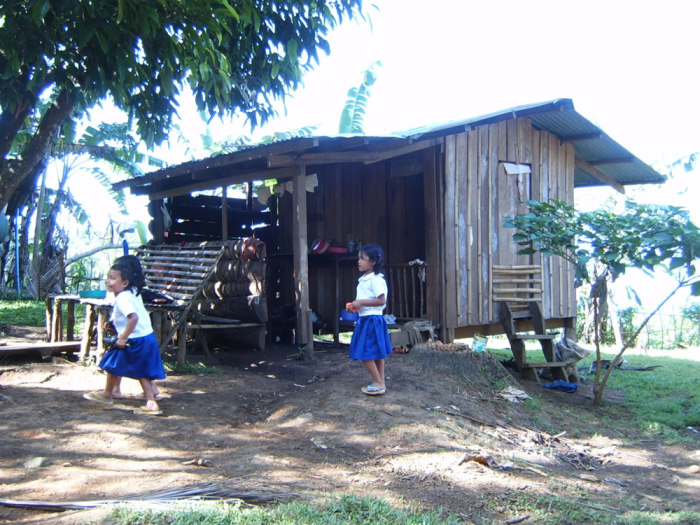
The wood is almost invariably taken from coconut palms and corrugated metal is the roofing material of choice, although tightly woven bamboo will sub for either in a pinch. The average occupancy of a household in San Isidro – of which those are the average size – is between 5 and 6 people, generally only 2 of which are adults. This *is* a Catholic country after all…
You can’t really complain about the location though. They certainly have a nice view from their coconut-wood porches.
I assure you the ocean is out there somewhere, it’s just hard to make out where the beautiful blue sky meets the astounding azure water…
And to give you a good idea of where these people are situated upon the mountainside, take a gander at this one.
The structures visible in the upper left are the same houses of which you’ve just seen close-up photos. The density of foliage in the unaltered areas is just staggering.
For the moment though, and the reason I’m able to post this entry for (I hope) your enjoyment, I am back in Cagayan De Oro. Melvin has a class to teach tomorrow and on Monday we’re headed to the local Customs & Immigration office to apply for an extension of my VISA. In order to “lubricate” the process there is almost certainly going to be cash required, both over and under the counter… I love the Philippines!
To sum up my research efforts to date, I’ve been primarily visiting with elected or NGO officials and rounding up reams of paperwork on every aspect of the CBFM project. Starting on the 27th however, things are going to get a lot more intimate… From the 27th of February to the 3rd of March, Melvin and I will actually be staying in San Isidro. We will be staying in a small house(let’s be honest, shack) that has no electricity but does have running(and again, freezing!) water.
During our 5-day stay we will survey the head of every single household in the barangay, nearly 80. They are all quite cooperative and willing to participate, but – conveniently for me – they don’t have a choice. Jorge has assured us that if anyone refuses to be surveyed they will be expelled from the CO, a Draconian step that shouldn’t be necessary — but hey, it’s always nice to have an Ace in your pocket. In addition to the surveys we’ll also conduct detailed personal interviews with all the officers past and present of the CO. I’ve already discovered that Jorge can’t stand the new governor(see Tammany Hall of Camiguin below) and is eager to tell us in great detail about the new governor’s efforts to interfere with the project. Off-the-record conflict like that is the sort of intangible thing that never shows up in balance sheets or progress reports, but greatly affects the outcome of any NGO effort and is very important for my evaluation.
One last laugher before I go: when asked during the survey trial if the CBFM project had improved his quality of life, Jorge replied with an emphatic “yes!” — When asked to elaborate he confidently and sincerely told us that “I save lots of money now. Whenever I need wood, instead of buying it at market I can just cut down a coconut tree!”
Nice to know you’re benefiting from those REFORESTATION EFFORTS Jorge… YIKES!!!
Lastly, for the ladies in the audience – and any men who pursue lifestyles of an alternative flavor I suppose – here is a picture of me on White Island…
…and a picture of my invaluable assistant, and always well-dressed Melvin Jabbar posing on the beach…
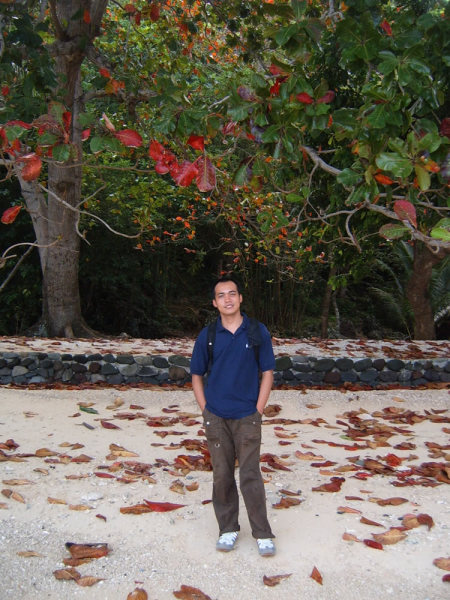
That’s all for now, broadcasts will resume on two weeks from now on March 4th after our one week survivor challenge in San Isidro – I promise tons of lovely new photographs.
